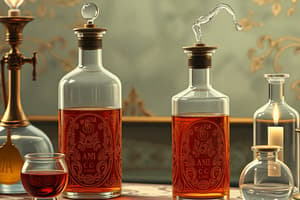Podcast
Questions and Answers
What is the density of a solution of vinegar if it contains 4.00% acetic acid by weight and its density is 1.049 g/ml?
What is the density of a solution of vinegar if it contains 4.00% acetic acid by weight and its density is 1.049 g/ml?
- 10.49 g/ml
- 4.00 g/ml
- 0.0400 g/ml
- 1.049 g/ml (correct)
What is the mass of acetic acid in 250.0 ml of a vinegar solution that is 4.00% acetic acid by weight and has a density of 1.049 g/ml?
What is the mass of acetic acid in 250.0 ml of a vinegar solution that is 4.00% acetic acid by weight and has a density of 1.049 g/ml?
- 262 g
- 1.05 g
- 4.00 g
- 10.5 g (correct)
What is the formula to convert Celsius to Fahrenheit?
What is the formula to convert Celsius to Fahrenheit?
- $\degree C = \degree F - 273.15$
- $\degree F = \degree C * 9/5 + 32$ (correct)
- $\degree C = (\degree F - 32) *5/9$
- $\degree C = \degree F + 273.15$
Which temperature scale uses water as a reference point?
Which temperature scale uses water as a reference point?
What is the boiling point of water in Kelvin?
What is the boiling point of water in Kelvin?
What is the key difference between heat and temperature?
What is the key difference between heat and temperature?
What determines the direction of heat flow?
What determines the direction of heat flow?
What is the density of a substance with a mass of 150 grams and a volume of 50 cm³?
What is the density of a substance with a mass of 150 grams and a volume of 50 cm³?
If you need 250 mL of a liquid with a density of 0.85 g/mL, what mass of the liquid do you need?
If you need 250 mL of a liquid with a density of 0.85 g/mL, what mass of the liquid do you need?
A piece of metal with a mass of 45 grams is placed in a graduated cylinder containing 10 mL of water. The water level rises to 15 mL. What is the density of the metal?
A piece of metal with a mass of 45 grams is placed in a graduated cylinder containing 10 mL of water. The water level rises to 15 mL. What is the density of the metal?
A solution has a specific gravity of 1.25. What does this tell us about the solution?
A solution has a specific gravity of 1.25. What does this tell us about the solution?
Why does ice float on water?
Why does ice float on water?
A 100 g sample of a substance occupies 25 cm³. What is its density?
A 100 g sample of a substance occupies 25 cm³. What is its density?
What is the volume of 350 g of a liquid with a density of 1.4 g/mL?
What is the volume of 350 g of a liquid with a density of 1.4 g/mL?
A graduated cylinder contains 20 mL of water. A 50 g metal object is placed in the cylinder, and the water level rises to 35 mL. What is the specific gravity of the metal?
A graduated cylinder contains 20 mL of water. A 50 g metal object is placed in the cylinder, and the water level rises to 35 mL. What is the specific gravity of the metal?
Flashcards
4.00% Acetic Acid
4.00% Acetic Acid
A solution indicating that 4 grams of acetic acid are in 100 grams of solution.
Density
Density
The mass per unit volume of a substance, measured in g/ml or kg/m³.
Calculating grams in solution
Calculating grams in solution
Method to find mass of solute by multiplying volume by density and concentration.
Significant Figures
Significant Figures
Signup and view all the flashcards
Dalton’s Postulates
Dalton’s Postulates
Signup and view all the flashcards
Chemical Properties
Chemical Properties
Signup and view all the flashcards
Mixtures vs. Pure Substances
Mixtures vs. Pure Substances
Signup and view all the flashcards
Molecular Weight
Molecular Weight
Signup and view all the flashcards
Mass of HCl in solution
Mass of HCl in solution
Signup and view all the flashcards
Heat vs Temperature
Heat vs Temperature
Signup and view all the flashcards
Temperature flow direction
Temperature flow direction
Signup and view all the flashcards
Common temperature scales
Common temperature scales
Signup and view all the flashcards
Celsius and Kelvin conversion
Celsius and Kelvin conversion
Signup and view all the flashcards
Specific Gravity
Specific Gravity
Signup and view all the flashcards
Why does ice float?
Why does ice float?
Signup and view all the flashcards
Calculating volume from density
Calculating volume from density
Signup and view all the flashcards
Water's density at room temperature
Water's density at room temperature
Signup and view all the flashcards
Density calculation example
Density calculation example
Signup and view all the flashcards
Calculating specific gravity
Calculating specific gravity
Signup and view all the flashcards
Concentration of HCl solution
Concentration of HCl solution
Signup and view all the flashcards
Study Notes
Chem 110 - Thought for the Day
- Neon has no chemistry on stage, suggesting a malfunctioning reactor.
Quiz 4 - Acetic Acid in Vinegar
- Vinegar is 4.00% acetic acid by weight.
- Vinegar has a density of 1.049 g/mL.
- The question asks for the grams of acetic acid in 250.0 mL of vinegar.
Math Review for Chem 110
- A drop-in workshop for math review is scheduled for Wednesday, January 22nd, at 12:15 PM in Room 216.
- The workshop is also available via Zoom; contact for details.
- Prof. Musolino's email address is [email protected] for questions.
Chem 110 - Reminders
- Cell phones are prohibited during class.
- Participation points are awarded for class engagement.
Chapter Goals for the Day
- Students need to learn about states of matter, Dalton's postulates, chemical and physical properties, mixtures/substances (compounds and elements).
- Students will learn about SI units, uncertainties in measurements, dimensional analysis, percentages, density, specific gravity, and heat transfer.
Chapter 2 Goals
- Topics for study in this chapter include chemical formulas, ionic compounds, formulas of some ionic compounds, atomic weights, moles; formula weights, molecular weights, and moles, percent composition and formulas of compounds, derivations of formulas, determination of molecular formulas, interpretation of chemical formulas, and purity of samples.
Density and Specific Gravity
- Weight, mass, and density are defined: density = mass/volume
- Ice floats in liquid water because its density is lower (less dense) than water's.
Density and Specific Gravity - Example 1-6
- The density of a substance with a mass of 742 g and a volume of 97.3 cm³ is 7.63 g/cm³.
Density and Specific Gravity - Example 1-7
- To find the volume of 125 g of a corrosive liquid with a density of 1.32 g/mL, divide the mass (125 g) by the given density (1.32 g/mL) which will give 94.7 mL.
Density and Specific Gravity - Specific Gravity
- Specific gravity is calculated by dividing the density of the substance by the density of water (at room temperature which is nearly 1.00 g/mL)
- Specific gravity has no units.
Density and Specific Gravity - Example 1-8
- A 31.0 gram piece of chromium is dropped into 5.00 mL of water. The water level rises to 9.32 mL.
- The specific gravity of chromium is calculated using its volume (4.32 cm³) and mass (31.0g). giving 7.1759 or 7.18.
Density and Specific Gravity - Example 1-9
- A hydrochloric acid solution is 36.31% HCl and 63.69% water by mass.
- The specific gravity is 1.185.
- The mass of pure HCl in 175 mL of this solution is 75.3 g.
Heat and Temperature
- Heat and temperature are different concepts.
- Heat is the transfer of energy.
- Temperature is intensity of heat.
- Temperatures are measured with different scales ( Fahrenheit, Celsius and Kelvin ) with water as a reference.
Heat and Temperature - Reference Points
- The freezing point of water is 0.000°C, 32.00°F, and 273.15 K.
- The boiling point of water is 100.0°C, 212.0°F, and 373.15 K.
Relationships of the Three Temperature Scales
- Fahrenheit and Celsius are related by °C = (°F – 32) * 5/9.
- °F = °C * 9/5 + 32
- K = °C + 273.15, °C = K – 273.15
Heat and Temperature - Example 1-11
- Converting 548 K to Celsius degrees is calculated by °C = 548-273 = 275°C
Heat Transfer and the Measurement of Heat
- The SI unit of heat is the Joule (J).
- A calorie is the amount of heat required to raise the temperature of 1 g of water by 1 °C.
- 1 calorie is equivalent to 4.184 J.
- Specific heat is the amount of heat required to raise the temperature of 1 g of a substance by 1 °C.
- The unit for specific heat is J/g°C
Heat Transfer and the Measurement of Heat - Example 1-12
- To find the amount of heat required to raise the temperature of 200.0 g of water from 10.0 °C to 55.0 °C, the equation q = m * C * AT is used where m is mass, C is specific heat and ΔT is the change in temperature.
- This gives a value of 3.76 x 104J or 37.6 kJ.
Heat Transfer and the Measurement of Heat - Example 1-13
- To find the amount of heat required to change the temperature of 200.0 grams of mercury from 10.0 °C to 55.0 °C using the given specific heat for mercury (0.138 J/g°C), the equation q = m * C * ΔT is used, which gives a value of 1242 J or 1.24 kJ.
Heat Transfer and the Measurement of Heat - Observations
- Raising the temperature of water requires significantly more heat than raising the same mass of mercury.
- The significant difference in specific heat is important to remember.
Chapter 2 Goals
- This chapter has topics on chemical formulas and ionic compounds; atomic weights and moles. Formula weights, molecular weights and moles; percent composition and formulas of compounds; derivations of formulas and determination of molecular formulas. Other interpretations of chemical formulas, and purity of samples.
Chemical Formulas and Composition Stoichiometry - Definitions
- Chemical formulas represent the elements and ratios in a compound.
- Allotropes are different structural forms of elements.
Names and Formulas of Some Molecular Compounds
- Tables of molecular compounds, with their corresponding names, formulas, and charges, for some common molecules such as water, acetic acid, and others are provided.
Chemical Formulas and Composition Stoichiometry - Definitions
- A compound is formed from two or more elements in fixed proportions.
- Organic compounds have C-C or C-H bonds, and potentially other components.
- Inorganic compounds do not have C-C or C-H components.
Periodic Table 1
- Atomic number represents the number of protons and electrons in an atom.
- Atomic mass (Molar mass) is the weighted average of all isotopes of an element.
- Periods (horizontal rows) correspond to electron energy levels.
- Groups (vertical columns) show the number of electrons in the outer shell of an atom.
Ions and Ionic Compounds
- Ions are atoms with a net electric charge.
- Cations are positively charged ions (often metals).
- Anions are negatively charged ions (often nonmetals).
- Polyatomic ions are groups of atoms with a net charge.
- Examples of ions include Na+, Ca2+, Al3+, and NH₄⁺. Examples of polyatomic anions include SO₄²⁻, PO₄³⁻.
Names and Formulas of Some Ions
- Tables of common ions including their names, formulas, and charges are given.
Studying That Suits You
Use AI to generate personalized quizzes and flashcards to suit your learning preferences.




